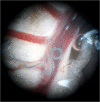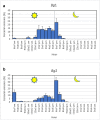Mastomys natalensis (Smith, 1834) as a natural host for Schistosoma haematobium (Bilharz, 1852) Weinland, 1858 x Schistosoma bovis Sonsino, 1876 introgressive hybrids
- PMID: 33687566
- PMCID: PMC8084788
- DOI: 10.1007/s00436-021-07099-7
Mastomys natalensis (Smith, 1834) as a natural host for Schistosoma haematobium (Bilharz, 1852) Weinland, 1858 x Schistosoma bovis Sonsino, 1876 introgressive hybrids
Abstract
Cercarial emission of schistosomes is a determinant in the transmission to the definitive host and constitutes a good marker to identify which definitive host is responsible for transmission, mainly in introgressive hybridization situations. Our goal was to test the hypothesis that micro-mammals play a role in Schistosoma haematobium, S. bovis, and/or S. haematobium x S. bovis transmission. Small mammal sampling was conducted in seven semi-lacustrine villages of southern Benin. Among the 62 animals trapped, 50 individuals were investigated for Schistosoma adults and eggs: 37 Rattus rattus, 3 Rattus norvegicus, 9 Mastomys natalensis, and 1 Crocidura olivieri. Schistosoma adults were found in four R. rattus and two M. natalensis, with a local prevalence reaching 80% and 50%, respectively. Two cercarial chronotypes were found from Bulinus globosus experimentally infected with miracidia extracted from naturally infected M. natalensis: a late diurnal and nocturnal chronotype, and an early diurnal, late diurnal, and nocturnal chronotype. The cytochrome C oxidase subunit I mtDNA gene of the collected schistosomes (adults, miracidia, and cercariae) belonged to the S. bovis clade. Eleven internal transcribed spacer rDNA profiles were found; four belonged to S. bovis and seven to S. haematobium x S. bovis. These molecular results together with the observed multi-peak chronotypes add M. natalensis as a new host implicated in S. haematobium x S. bovis transmission. We discuss the origin of the new chronotypes which have become more complex with the appearance of several peaks in a 24-h day. We also discuss how the new populations of offspring may optimize intra-host ecological niche, host spectrum, and transmission time period.
Keywords: Cercarial chronobiology; Mastomys natalensis; Rattus rattus; Schistosoma haematobium x Schistosoma bovis; Schistosome transmission.
Conflict of interest statement
The authors declare no competing interests.
Figures





Similar articles
-
Cattle as natural host for Schistosoma haematobium (Bilharz, 1852) Weinland, 1858 x Schistosoma bovis Sonsino, 1876 interactions, with new cercarial emergence and genetic patterns.Parasitol Res. 2020 Jul;119(7):2189-2205. doi: 10.1007/s00436-020-06709-0. Epub 2020 May 29. Parasitol Res. 2020. PMID: 32468189
-
Interactions between Schistosoma haematobium group species and their Bulinus spp. intermediate hosts along the Niger River Valley.Parasit Vectors. 2020 May 24;13(1):268. doi: 10.1186/s13071-020-04136-9. Parasit Vectors. 2020. PMID: 32448268 Free PMC article.
-
Molecular characterization and distribution of Schistosoma cercariae collected from naturally infected bulinid snails in northern and central Côte d'Ivoire.Parasit Vectors. 2019 Mar 19;12(1):117. doi: 10.1186/s13071-019-3381-3. Parasit Vectors. 2019. PMID: 30890180 Free PMC article.
-
Interactions between intermediate snail hosts of the genus Bulinus and schistosomes of the Schistosoma haematobium group.Parasitology. 2001;123 Suppl:S245-60. doi: 10.1017/s0031182001008046. Parasitology. 2001. PMID: 11769287 Review.
-
A review of the biology and transmission ecology of African bovine species of the genus Schistosoma.Z Parasitenkd. 1983;69(5):551-70. doi: 10.1007/BF00926667. Z Parasitenkd. 1983. PMID: 6356670 Review.
Cited by
-
Schistosoma haematobium and Schistosoma bovis first generation hybrids undergo gene expressions changes consistent with species compatibility and heterosis.PLoS Negl Trop Dis. 2024 Jul 2;18(7):e0012267. doi: 10.1371/journal.pntd.0012267. eCollection 2024 Jul. PLoS Negl Trop Dis. 2024. PMID: 38954732 Free PMC article.
-
Reaching the World Health Organization elimination targets for schistosomiasis: the importance of a One Health perspective.Philos Trans R Soc Lond B Biol Sci. 2023 Oct 9;378(1887):20220274. doi: 10.1098/rstb.2022.0274. Epub 2023 Aug 21. Philos Trans R Soc Lond B Biol Sci. 2023. PMID: 37598697 Free PMC article. Review.
-
Genomic evidence of contemporary hybridization between Schistosoma species.PLoS Pathog. 2022 Aug 8;18(8):e1010706. doi: 10.1371/journal.ppat.1010706. eCollection 2022 Aug. PLoS Pathog. 2022. PMID: 35939508 Free PMC article.
-
Population Genetic Structure and Hybridization of Schistosoma haematobium in Nigeria.Pathogens. 2022 Mar 31;11(4):425. doi: 10.3390/pathogens11040425. Pathogens. 2022. PMID: 35456103 Free PMC article.
-
Mating Interactions between Schistosoma bovis and S. mansoni and Compatibility of Their F1 Progeny with Biomphalaria glabrata and Bulinus truncatus.Microorganisms. 2022 Jun 19;10(6):1251. doi: 10.3390/microorganisms10061251. Microorganisms. 2022. PMID: 35744769 Free PMC article.
References
-
- Boissier J, Mouahid G, Moné H (2019) Schistosoma spp. In: J.B. Rose and B. Jiménez-Cisneros, (eds) Global water pathogen project. http://www.waterpathogens.org (http://www.waterpathogens.org/) (Robertson, L (eds) Part 4 Helminths) http://www.waterpathogens.org/book/schistosoma (https://www.waterpathogens.org/book/schistosoma) Michigan State University, E. Lansing, MI, UNESCO.
-
- Christensen JT. Home range and abundance of Mastomys natalensis (Smith, 1834) in habitats affected by cultivation. Afr J Ecol. 1996;34(3):298–311. doi: 10.1111/j.1365-2028.1996.tb00624.x. - DOI
MeSH terms
Substances
Grants and funding
LinkOut - more resources
Full Text Sources
Other Literature Sources

